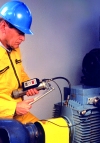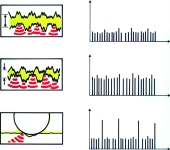Bearing condition monitoring - Part 3
August 2006
Maintenance, Test & Measurement, Calibration

Last time we looked at the development of the shock pulse method and how it measures bearing damage. But as they always say in the advertisement, "But wait that is not all..."
During development of the shock pulse method it was found that there are two distinct shock pulses. These can be described as erratic high amplitude shocks and low amplitude 'continuous' shocks. When analysing these two types of shocks it was determined that the erratic high amplitude shocks are associated with insipient bearing damage. But what does the low amplitude value represent?
To answer this question one has to look at microscopic level at the two contact surfaces, the bearing outer race and the rolling element. One also has to consider the lubrication film separating these two surfaces. The lubricant film is a very thin sliver, some 0,4 microns thick. The contact area of the rolling element and the outer race is 400 times larger than the lubricant film thickness. Even so, the total contact area is very small! If one considers the load on this contact area it is considerable at about 10 000 kPa.

The lubricant film is relatively static when compared to the rolling elements passing over it. The lubricant film is subjected to this tremendous pressure every time an element passes overhead. This pressure forces the lubricant into the asparities of the two contact surfaces. The lubricant forced into the asparities by this huge pressure causes shocks. These are the shocks that are measured by the transducer as the continuous low amplitude shocks. If one looks at the distribution of these low amplitude shocks they represent a normal distribution. If the lubricant film is reduced there is no longer a complete separation of the two contact surfaces and there is an increased metal-to-metal contact.
Thus, an increase in amplitude of these low amplitude continuous shocks indicates a reduced lubricant film thickness, in other words poorer lubrication. There you have it, one can also measure lubricant film thickness with the shock pulse method. All of this from a very simple method developed in the 60s.
In the next issue we will look at how measurements at these extremely low amplitudes are possible.
For more information contact Vegter Condition Monitoring, +27 (0) 11 849 6876, [email protected]
Further reading:
New frequency counter with 10 digits of resolution
Comtest
Maintenance, Test & Measurement, Calibration
B&K Precisio has a new series of universal frequency counters designed for a wide range of frequency measurement applications.
Read more...
Verification using Heartbeat Technology is a breeze
Maintenance, Test & Measurement, Calibration
Heartbeat Technology reflects Endress+Hauser’s long-term commitment to enhancing measurement reliability and efficiency across a growing product portfolio.
Read more...
Clog-resistant nozzle for powerful stationary tank cleaning
Maintenance, Test & Measurement, Calibration
As EXAIR and BETE continue to build on a strong partnership, EXAIR has recently added a selection of BETE products to the site, including the innovative BETE HydroClaw tank and vessel cleaning nozzle.
Read more...
Clog-resistant nozzle for powerful
Maintenance, Test & Measurement, Calibration
As EXAIR and BETE continue to build on a strong partnership, EXAIR has recently added a selection of BETE products to the site, including the innovative BETE HydroClaw tank and vessel cleaning nozzle.
Read more...
Why your next oscilloscope should
Comtest
Maintenance, Test & Measurement, Calibration
The PC-based USB oscilloscope is a cutting-edge, adaptable alternative to traditional benchtop oscilloscopes that’s redefining test and measurement.
Read more...
Automated test and measurement
Comtest
Maintenance, Test & Measurement, Calibration
Comtest, in partnership with global brands, provides customised solutions with integrated hardware and software for efficient testing and data collection.
Read more...
Advanced field calibrator and communicator
Maintenance, Test & Measurement, Calibration
The Beamex MC6 is a high-accuracy field calibrator that offers automatic calibration capabilities for pressure, temperature and various electrical signals.
Read more...
Inline particle measurement
Mecosa
Maintenance, Test & Measurement, Calibration
Part of the SOPAT family, Parsum has for more than 20 years stood for the measurement of particles in a running process - without sampling and without a laboratory.
Read more...
Inline analysis measurement technology
Mecosa
Maintenance, Test & Measurement, Calibration
SOPAT develops and sells a photo-optical and image-based inline analysis measurement technology that quantitatively characterises particulate multi-phase systems. The software provides real-time analysis of particle size distribution.
Read more...
UV water treatment system
Maintenance, Test & Measurement, Calibration
bestUV is an innovative manufacturer of professional ultraviolet (UV) water treatment systems for industrial markets.
Read more...



